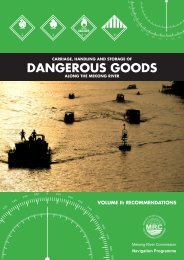Adaptation to climate change in the countries of - Mekong River ...
Adaptation to climate change in the countries of - Mekong River ...
Adaptation to climate change in the countries of - Mekong River ...
You also want an ePaper? Increase the reach of your titles
YUMPU automatically turns print PDFs into web optimized ePapers that Google loves.
Exist<strong>in</strong>g knowledge <strong>of</strong> national <strong>climate</strong> <strong>change</strong><br />
Water resources are particularly vulnerable <strong>to</strong> <strong>the</strong> effects <strong>of</strong> <strong>climate</strong> <strong>change</strong>. Water run<strong>of</strong>f<br />
from <strong>the</strong> <strong>Mekong</strong> <strong>River</strong> Delta <strong>of</strong> Viet Nam <strong>to</strong> <strong>the</strong> East Sea is 505 billion m 3 /year. The spatial<br />
and temporal distribution <strong>of</strong> run<strong>of</strong>f is very uneven; more than 80% <strong>of</strong> run-<strong>of</strong>f is concentrated <strong>in</strong><br />
summer (5 – 6 months), while <strong>the</strong> rest (20%) occurs dur<strong>in</strong>g <strong>the</strong> 6 – 7 months <strong>of</strong> <strong>the</strong> dry season<br />
(Sou<strong>the</strong>rn Institute for Water Resources Plann<strong>in</strong>g, 2008c).<br />
Due <strong>to</strong> global warm<strong>in</strong>g, <strong>the</strong> plant<strong>in</strong>g boundaries <strong>of</strong> some crops could <strong>change</strong> as temperature<br />
and ra<strong>in</strong>fall patterns are modified. Due <strong>to</strong> abnormal <strong>change</strong>s <strong>in</strong> ra<strong>in</strong>fall <strong>in</strong>tensity, flood<br />
<strong>in</strong>undation and drought could occur more frequently. Significant cultivation areas <strong>in</strong> <strong>Mekong</strong><br />
delta could be under salt water due <strong>to</strong> sea level rise. SEA START RC (2006) found that rice<br />
production <strong>in</strong> <strong>the</strong> <strong>Mekong</strong> Delta <strong>in</strong> Viet Nam may be severely impacted by <strong>climate</strong> <strong>change</strong>,<br />
especially summer autumn crop production, where yield may be reduced by over 40%. Food<br />
scarcity could <strong>in</strong>crease as supply fails <strong>to</strong> meet <strong>the</strong> demands <strong>of</strong> a grow<strong>in</strong>g population. The<br />
<strong>to</strong>tal area <strong>of</strong> agricultural activities could be reduced result<strong>in</strong>g <strong>in</strong> food scarcity and higher food<br />
prices that could affect not only this region, but <strong>the</strong> whole country given <strong>the</strong> importance <strong>of</strong> <strong>the</strong><br />
<strong>Mekong</strong> Delta for national food production.<br />
The area <strong>of</strong> mangrove forest <strong>in</strong> <strong>the</strong> region is expected <strong>to</strong> decrease due <strong>to</strong> SLR, <strong>in</strong>creased<br />
<strong>in</strong>cidence <strong>of</strong> droughts, and <strong>in</strong>creased erosion and wave action (Phan and Le, 2008). Terrestrial<br />
forest ecosystems could also be affected with <strong>change</strong>s <strong>in</strong> temperature and drought <strong>in</strong>cidence<br />
lead<strong>in</strong>g <strong>to</strong> <strong>in</strong>creas<strong>in</strong>g danger <strong>of</strong> forest fire development and spread<strong>in</strong>g <strong>of</strong> plant pests and<br />
diseases. Sal<strong>in</strong>ity <strong>in</strong>trusion due <strong>to</strong> s<strong>to</strong>rm surge, extreme tidal flood<strong>in</strong>g and SLR <strong>in</strong> <strong>the</strong> <strong>Mekong</strong><br />
Delta is expected <strong>to</strong> lead <strong>to</strong> a reduction <strong>in</strong> <strong>the</strong> area and quality <strong>of</strong> habitat for freshwater<br />
organisms and affect <strong>the</strong> vertical distribution structure <strong>of</strong> ecosystems.<br />
Infectious diseases that are common <strong>in</strong> <strong>the</strong> region <strong>in</strong>clude malaria, synaptic filariasis, dengue<br />
fever, and Japanese encephalitis. It is predicted that <strong>in</strong>creased temperatures could facilitate <strong>the</strong><br />
growth and development <strong>of</strong> various viruses and <strong>in</strong>sects act<strong>in</strong>g as disease carriers.<br />
Infrastructure, energy and <strong>in</strong>dustry would potentially be affected <strong>in</strong> a number <strong>of</strong> ways. S<strong>to</strong>rm<br />
surge, extreme tidal flood<strong>in</strong>g and monsoon ra<strong>in</strong>s and sea level rise would <strong>in</strong>undate lowlands,<br />
lead<strong>in</strong>g <strong>to</strong> <strong>in</strong>creas<strong>in</strong>g energy consumption for pump<strong>in</strong>g and dra<strong>in</strong>age. The Delta region conta<strong>in</strong>s<br />
many important economic <strong>in</strong>dustrial zones and aquaculture areas located <strong>in</strong> low-ly<strong>in</strong>g coastal<br />
areas which could face <strong>in</strong>creased challenges from floods and ris<strong>in</strong>g sea level. Climate <strong>change</strong><br />
could cause difficulties <strong>in</strong> water and material supply for <strong>in</strong>dustries and construction such as<br />
exploitation and process<strong>in</strong>g <strong>of</strong> agricultural products, forest product and aquaculture products,<br />
<strong>in</strong>dustrial and domestic construction, and communication. More frequent extreme s<strong>to</strong>rms,<br />
flood<strong>in</strong>g and sal<strong>in</strong>ity would reduce life span <strong>of</strong> materials, equipment, mach<strong>in</strong>es, and build<strong>in</strong>gs,<br />
and ma<strong>in</strong>tenance costs would be higher. Sea level rise could affect coastal beaches and thus<br />
<strong>to</strong>urism; it could also affect cultural and his<strong>to</strong>rical heritage and preservation areas (Sou<strong>the</strong>rn<br />
Institute for Water Resources Plann<strong>in</strong>g 2008a,b, c).<br />
Page 23













